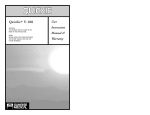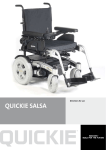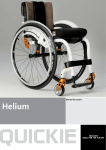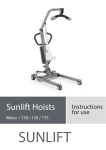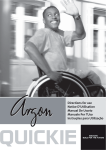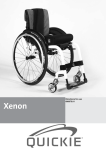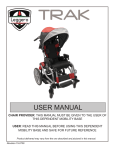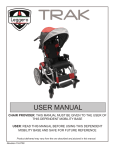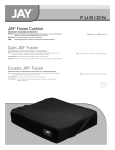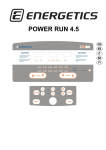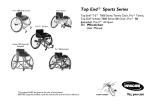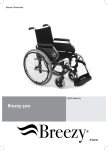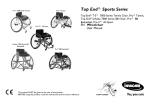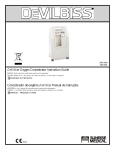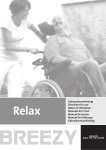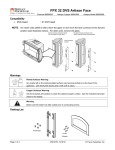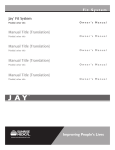Download BasiX RubiX /RubiX Komfort RubiX XL /RubiX XL Komfort
Transcript
BasiX RubiX /RubiX Komfort RubiX XL /RubiX XL Komfort Directions for use Käyttöohjeet Gebrauchsanweisung Pokyny k použití Notice d’utilisation Instrukcja użytkowania Gebruikershandleiding Manual de usuario Instruções para Utilização Manuale per l'uso Brukerveiledning Användarinstruktion Brugervejledning Dear Customer, We are very happy that you have decided in favour of a high-quality SUNRISE MEDICAL product. Table of contents Foreword about wheelchairs General safety notes and driving restrictions . . . . . . . . . . . . . . 3 - 4 This user’s manual will provide numerous tips and ideas so that your new wheelchair can become a trustworthy and reliable partner in your life. Warranty . . . . . . . . . . . . . . . . . . . . . . . . . . . . . . . . . . . . . . . . . . . . . 4 Maintaining close ties to our customers means a lot to us at Sunrise Medical, therefore we like to keep you up-to-date about new and current developments at our company. Close customer ties also mean fast service when you need replacement parts or accessories or just have a question about your wheelchair - and with as little red tape as possible. Wheelchair components . . . . . . . . . . . . . . . . . . . . . . . . . . . . . . . . . 7 We want you to be satisfied with our products and service. Sunrise Medical has been consistently working at continuously developing its products, for this reason, changes can occur in our palette of products with regard to form, technology and equipment. Consequently, no claims can be construed from the data or pictures contained in this user’s manual. The management system of SUNRISE MEDICAL is certified to ISO 9001, ISO 13485 and ISO 14001. As the manufacturer, SUNRISE MEDICAL, declares that the lightweight wheelchairs conform to the 93/42/EWG guideline. In addition, they fulfil the performance requirements for the "Crash Test" to ISO 7176-19. Please contact your local, authorised SUNRISE MEDICAL dealer if you have any questions regarding the use, maintenance or safety of your wheelchair. In case there is no authorised dealer in your area or you have any questions, contact Sunrise Medical either in writing or by telephone (contact addresses can be found on the back page). Sunrise Medical Limited High Street Wollaston West Midlands DY8 4PS England Tel.: +44 (0) 1384446688 www.sunrisemedical.com Please keep a note of your local service agent’s address and telephone number in the space below. Transportability . . . . . . . . . . . . . . . . . . . . . . . . . . . . . . . . . . . . . 5 - 6 Handling Folding and unfolding . . . . . . . . . . . . . . . . . . . . . . . . . . . . . . . . . . . 8 Options Step tubes . . . . . . . . . . . . . . . . . . . . . . . . . . . . . . . . . . . . . . . . . . . . 8 Brakes . . . . . . . . . . . . . . . . . . . . . . . . . . . . . . . . . . . . . . . . . . . . . . . 8 Footplates . . . . . . . . . . . . . . . . . . . . . . . . . . . . . . . . . . . . . . . . . . . . 9 Castors . . . . . . . . . . . . . . . . . . . . . . . . . . . . . . . . . . . . . . . . . . . . . 10 Castor adapter . . . . . . . . . . . . . . . . . . . . . . . . . . . . . . . . . . . . . . . . 10 Backrests . . . . . . . . . . . . . . . . . . . . . . . . . . . . . . . . . . . . . . . . . . . . 10 Hemiplegic armrest . . . . . . . . . . . . . . . . . . . . . . . . . . . . . . . . . . . . 11 Sideguard . . . . . . . . . . . . . . . . . . . . . . . . . . . . . . . . . . . . . . . . . . . 11 Anti-tip tubes . . . . . . . . . . . . . . . . . . . . . . . . . . . . . . . . . . . . . . . . . 11 Lap belt . . . . . . . . . . . . . . . . . . . . . . . . . . . . . . . . . . . . . . . . . . . . . 12 Seat . . . . . . . . . . . . . . . . . . . . . . . . . . . . . . . . . . . . . . . . . . . . . . . . 12 Seat depth . . . . . . . . . . . . . . . . . . . . . . . . . . . . . . . . . . . . . . . 12 - 13 Push handles . . . . . . . . . . . . . . . . . . . . . . . . . . . . . . . . . . . . . . . . . 13 Crutch holder . . . . . . . . . . . . . . . . . . . . . . . . . . . . . . . . . . . . . . . . . 13 Therapy table . . . . . . . . . . . . . . . . . . . . . . . . . . . . . . . . . . . . . . . . .13 Stabilising bar . . . . . . . . . . . . . . . . . . . . . . . . . . . . . . . . . . . . . . . . 13 Headrests . . . . . . . . . . . . . . . . . . . . . . . . . . . . . . . . . . . . . . . . . . . 13 Transit wheels . . . . . . . . . . . . . . . . . . . . . . . . . . . . . . . . . . . . . . . . 13 One-hand operation . . . . . . . . . . . . . . . . . . . . . . . . . . . . . . . . . . . .13 Tyres and mounting . . . . . . . . . . . . . . . . . . . . . . . . . . . . . . . . . . . . 14 Trouble-shooting . . . . . . . . . . . . . . . . . . . . . . . . . . . . . . . . . . . . . . 14 Maintenance and care . . . . . . . . . . . . . . . . . . . . . . . . . . . . . . . . . . 14 Technical data . . . . . . . . . . . . . . . . . . . . . . . . . . . . . . . . . . . . 15 - 17 Nameplates . . . . . . . . . . . . . . . . . . . . . . . . . . . . . . . . . . . . . . . . . . 18 Torque . . . . . . . . . . . . . . . . . . . . . . . . . . . . . . . . . . . . . . . . . . . . . . 18 Assembly instruction . . . . . . . . . . . . . . . . . . . . . . . . . . . . . 235 - 236 Use Lightweight wheelchairs are exclusively for a user who is unable to walk or has limited mobility, for their own personal use. Warranty can only be taken on if the product is used under the specified conditions and for the intended purposes. The intended lifetime of the wheelchair is 5 years. Please DO NOT use or fit any 3rd party components to the wheelchair. Area of application In the event of a breakdown, contact them and try to give all relevant details so they can help you quickly. IMPORTANT: DO NOT USE YOUR WHEELCHAIR UNTIL THIS MANUAL HAS BEEN READ AND UNDERSTOOD. Symbol legend Danger! Warning messages regarding possible risks of accident or injury. Note: Information for operating the product. Caution: Warning messages regarding possible technical damages. 0707/1/ST-000690646.EMS The variety of fitting variants as well as the modular design mean that it can be used by those who cannot walk or have limited mobility because of: • Paralysis • Loss of extremity (leg amputation) • Extremity defect deformity • Joint contractures/joint injuries • Illnesses such as heart and circulation deficiencies, disturbance of equilibrium or cachexia as well as for elderly people who still have strength in the upper body. When considering provision, please also note the body size, weight, physical and psychological constitution, the age of the person, living conditions and environment. BasiX, RubiX, RubiX XL Rev. 2 2 ENGLISH Foreword General safety notes and driving restrictions The engineering and construction of this wheelchair has been designed to provide maximum safety. International safety standards currently in force have either been fulfilled Exceeded in parts. Nevertheless, users may put themselves at risk by improperly using their wheelchairs. For your own safety, the following rules must be strictly observed. Unprofessional or erroneous changes or adjustments increase the risk of accident. As a wheelchair user, you are also part of the daily traffic on streets and pavements, just like anyone else. We would like to remind you that you are therefore also subject to any and all traffic laws. Be careful during your first ride in this wheelchair. Get to know your wheelchair. Before each use, the following should be checked: • - Quick-release axles on the rear wheels • - Velcro on seats and backrests • - Tyres, tyre pressure, and wheel locks. ENGLISH Before changing any of the adjustments of this wheelchair, it is important to read the corresponding section of the user’s manual. It is possible that potholes or uneven ground could cause this wheelchair to tip over, especially when riding uphill or downhill. When riding over a step or up an incline frontally, the body should be leaning forward. > 10° 3 BasiX, RubiX, RubiX XL Rev. 2 Danger! NEVER exceed the maximum load of 125 kg (160 kg on the reinforced version) for driver plus any items carried on the wheelchair. If you exceed the maximum load, this can lead to damage to the chair, or you may fall or tip over, lose control and may lead to serious injury of the user and other people. Danger! To avoid falls and dangerous situations, you should first practice using your new wheelchair on level ground with good visibility. Danger! When getting on or off the wheelchair, do not use the footboards. These should be flipped up beforehand and swung to the outside as far as possible. Danger! Depending on the diameter and setting of the castors, as well as the centre of gravity setting of the wheelchair the castors may begin to wobble at high speeds. This can lead to the castors being blocked and the wheelchair may tip over. Therefore, please make sure that the castors are adjusted correctly (see the Chapter "Castors"). In particular, do not travel on an incline without brakes, travel at a reduced speed. Danger! Explore the effects of changing the centre of gravity on the behaviour of the wheelchair, for example on inclines, slopes, all gradients or when overcoming obstacles. Do this with the secure aid of a helper. We recommend that novice users use anti-tip tubes. Danger! It is possible that potholes or uneven ground could cause this wheelchair to tip over, especially when riding uphill or downhill. Danger! Anti-tip tubes should prevent the chair tipping over backwards unintentionally. Under no circumstances should they take the place of transit wheels, and be used to transport a person in a wheelchair with the rear wheels removed. Danger! With extreme settings (e.g. rear wheels in the most forward position) and less than perfect posture, the wheelchair may tip over even on a level surface. Danger! Lean your upper body further forward when going up slopes and steps. Danger! Lean your upper body further back when going down slopes and steps. Danger! When reaching for objects (which are in front of, to the side or behind the wheelchair) make sure that you do not lean too far out of the wheelchair, as if you change the centre of gravity there is a risk of tipping or rolling over. Danger! Only use your wheelchair properly. For example, avoid travelling against an obstacle without braking (step, kerb edge) or dropping down gaps. Danger! Only attempt stairs with the help of an attendant. There is equipment available to help you, e.g. climbing ramps or lifts, please use them. If there is no such equipment available, then the wheelchair must be tipped and pushed over the steps (2 helpers). In general, any anti-tip tubes fitted must be set beforehand, so that they cannot touch the steps, as otherwise this could lead to a serious tumble. Afterwards the anti-tip tubes must be set back to their correct position. Danger! Make sure that the attendant only holds the wheelchair using securely mounted parts (e.g. not on the footrests or the sideguards). Danger! When using the lifting ramp make sure that the anti-tip tubes fitted are positioned outside the danger area. Danger! Secure your wheelchair on uneven ground or when transferring (e.g. into a car) by using the brakes. 0707/1/ST-000690646.EMS 0707/1/ST-000690646.EMS Warranty The products shown and described in this manual may not be exactly the same in every detail as your own model. However, all instructions are still entirely relevant, irrespective of detail differences. The manufacturer reserves the right to alter without notice any weights, measurements, or other technical data shown in this manual. All figures, measurements, and capacities shown in this manual are approximate and do not constitute specifications. Guarantee THIS IN NO WAY AFFECTS YOUR STATUTORY RIGHTS. Warranty conditions 1) The repair or replacement will be carried out by an authorised Sunrise Medical dealer/service agent. 2) To apply the warranty conditions, should your product require attention under these arrangements, notify the designated Sunrise Medical service agent immediately giving full information about the nature of the difficulty. Should you be operating the product away from the locality of the designated Sunrise Medical service agentwork under the "Warranty Conditions” will be carried out by any other service agent designated by the manufacturer. ENGLISH Danger! For thigh amputees you must position the rear wheels towards the back and/or use anti-tip tubes. Danger! Before setting off, check that your tyre pressure is correct. The correct tyre pressure is printed on the edge of the wheel, for rear wheels it should be at least 3.5 bar ( 350 kPa). The knee-lever brakes will only work if there is sufficient tyre pressure and if the correct setting has been made (see the Chapter on "Brakes"). Danger! The wheel locks are not intended to brake your wheelchair. They are only there to ensure that your wheelchair does not begin rolling unintentionally. When you stop on uneven ground, you should always use the wheel locks to prevent such rolling. Always apply both wheel locks; otherwise, your wheelchair could tip over. Danger! If the seat and back sling are damaged, you must replace them immediately. Danger! Be careful with fire, in particular with burning cigaretts. Seat and back slings can be set alight. Danger! To avoid injuries to the hand, when operating the wheelchair, grip between the rear wheel and the knee-lever brake. Danger! If and whenever possible, during a journey in a specially fitted vehicle for disabled people, vehicle occupants should use the seats in the vehicle and the appropriate restraint system. This is the only way to ensure that occupants will have the maximum protection if there is an accident. When using safety elements offered by SUNRISE MEDICAL and using a specially designed safety system, lightweight wheelchairs can be used as a seat when being transported in a specially fitted vehicle. (See the Chapter on "Transportation"). Danger! Always make sure that the quick-release axles on the rear wheels are set properly. If the button on the quick-release axle is not pressed in, the rear wheel cannot be removed. Danger! In particular when using lightweight metal handrims, fingers will easily become hot when braking from a high speed or on long inclines. Danger! If the wheelchair is subject to direct sunlight for a long period of time, then parts of the wheelchair (e.g. frame, legrests, brakes and sideguard) may become hot (>41°C). Note ! When using the chair outside, always wear leather gloves which will increase your grip and protect the fingers from dirt and overheating. Note ! The effect of the knee-lever brake as well as the general driving characteristics are dependant on tyre pressure. The wheelchair is significantly lighter and easier to manoeuvre when the rear wheels are pumped up correctly and both wheels have the same pressure. Note ! Make sure that your tyres have sufficient tread! Please note that you are subject to any and all traffic laws when driving in public traffic. Note ! When it is dark, please wear light clothing or clothing with reflectors, so that you can be seen more easily. Make sure that the reflectors on the side and back of the wheelchair are clearly visible. We would also recommend that you fit an active light. Note ! Do not use the wheelchair on slopes > 10°. Do not use your wheelchair on muddy or icy ground. Do not use your wheelchair where pedestrians are not allowed. Note ! Always be careful with your fingers when working or adjusting the wheelchair! 3) Should any part of the wheelchair require repair or replacement, as a result of a specific manufacturing or material defect, within 24 months (5 years on frame and cross brace) from the date on which the possession of the product was transferred to the original purchaser, and subject to it remaining within that ownership, the part or parts will be repaired or replaced completely free of charge if returned to the authorised service agent. Note: This guarantee is not transferable. 4) Any repaired or replaced part will benefit from these arrangements for the balance of the warranty period applicable to the wheelchair. 5) Parts replaced after the original warranty has expired are covered for a further 24 months. 6) Items of a consumable nature will not generally be covered during the normal warranty period, unless such items have clearly suffered undue wear as a direct result of an original manufacturing defect. These items include amongst others upholstery, tyres, inner tubes, and similar parts. On powered products this will also include batteries, motor brushes etc. 7) The above warranty conditions apply to all product parts for models purchased at full retail price. 8) Under normal circumstances, no responsibility will be accepted where the product has required repair or replacement as a direct result of: a) The product or part not having been maintained or serviced in accordance with the manufacturer’s recommendations, as stated in the Owner`s Manual and / or Service Manual. Failing to use only the specified original equipment parts. b) The product or part having been damaged by neglect, accident or improper use. c) The product or part having been altered from the manufacturer’s specifications, or repairs having been attempted prior to the service agent being notified. BasiX, RubiX, RubiX XL Rev. 2 4 Transportability Transportation of your wheelchair within a vehicle A wheelchair secured in a vehicle will not provide the equivalent level of safety and security as a vehicle seating system. Sunrise Medical recommends that the user transfers to the vehicle seating and uses the vehicle-installed restraint system wherever possible. Sunrise Medical recognises that it is not always practical for the user to be transferred and in these circumstances, where the user must be transported whilst in the wheelchair, the following advice must be followed: Upper Torso restraint belt Pelvic restraint belt Warnings: ENGLISH The occupied wheelchair must be located in a forward facing position and secured by the wheelchair tie down and occupant restraint straps (WTORS tie downs meeting the requirements of ISO 10542 or SAE J2249) in accordance with the WTORS manufacturer’s instructions. Refer to the section ‘Tie down Instructions’ for further information on transporting your wheelchair. The wheelchair’s use in other positions within a vehicle has not been tested e.g. transportation in a side facing position must not be carried out under any circumstances. A head restraint suitable for transportation (see label of headrest) must be fitted and suitably positioned at all times during transportation. Postural supports (lap straps, lap belts) should not be used or relied on for occupant restraint in a moving vehicle unless they are labelled as meeting the requirements specified in ISO 7176-19:2001 or SAE J2249. The manual brakes must be firmly applied. Occupant Restraint Instructions The pelvic restraint belt must be worn low across the front of the pelvis so that the angle of the pelvic belt is within the preferred zone of 30 to 75 degrees to the horizontal. Wherever possible remove and stow safely away from the wheelchair all auxiliary equipment, for example: Crutches Loose cushions Tray tables A steeper (greater) angle within the preferred zone is desirable i.e. closer to, but never exceeding 75°. Preferred zone Alterations or substitutions must not be made to the wheelchair securement points or to structural and frame or components without consulting the manufacturer. Failure to do so will invalidate the ability of the wheelchair to be transported within a vehicle. The wheelchair should be inspected by a Sunrise Medical Authorised Dealer before re-use following involvement in any type of vehicle impact. Both pelvic and upper torso restraint belts must be used to restrain the occupant to reduce the possibility of head and chest impacts with the vehicle components.) 5 BasiX, RubiX, RubiX XL Rev. 2 0707/1/ST-000690646.EMS Restraint belts must not be held away from the body by wheelchair components or parts such as the armrests or wheels. The upper torso restraint belt must fit over the shoulder and across the chest as illustrated. Restraint belts must be adjusted as tightly as possible consistent with user comfort. Restraint belt webbing must not be twisted when in use. The lap and diagonal restraints should be routed through the gap between the seat and backrest. Transportability – positioning of wheelchair tie down restraints on wheelchair A self-propelling wheelchair secured with front and rear wheelchair tie down restraints. The attachment points to the chair are the inner front side frame just above the castor and the rear side frame. The straps are fitted around the side frames at the intersection of the horizontal and vertical frame tubes. ENGLISH Incorrect placement of the headrest b) Sufficient space should be available around the wheelchair to enable clear access to attach, tighten and release the wheelchair and occupant tie down restraints and safety belts. c) The tie down restraints should be fitted to the main frame of the wheelchair and not to any attachments or accessories, e.g. not around the spokes of wheels, brakes or footrests. d) The tie down restraints should be attached as close as possible at an angle of 45 degrees and tightened securely in accordance with the manufacturer’s instructions. e) The safety of the user during transportation depends upon the diligence of the person securing the tie down restraints and they should have received appropriate instructions and/or training in their use. Pelvic restraints should make full contact across the front of the body near the junction of the thigh and pelvis Correct placement of the headrest The tie down symbol on the wheelchair frame indicates the position of the wheelchair restraint straps. The straps are then tensioned after the front straps have been fitted to secure the wheelchair. 1. Confirm that the vehicle is suitably equipped to transport a passenger in a wheelchair and has access that is suitable for your wheelchair type. 2. Sunrise Medical Ltd. recommends: The use of a lower leg restraint, placed around the shins and around the front frame just above the castors. a) That the wheelchair be secured by a 4-part (webbing) Tie Down Restraint system, conforming to ISO 10542 or SAE J2249 with non-adjustable front straps and adjustable rear straps, which typically use Karabiner clips/S hooks and tongue and buckle attachments. 0707/1/ST-000690646.EMS BasiX, RubiX, RubiX XL Rev. 2 6 Wheelchair Components Wheelchairs: 1. Push handles 2. Backrest upholstery 3. Sideguard 4. Seat sling 5. Footrest 6. Castors 7. Footboard 8. Fork 9. Quick-release axle 10. Wheel locks 11. Handrim 12. Rear wheel 1 ENGLISH 2 3 4 5 9 11 8 6 7 BasiX, RubiX, RubiX XL Rev. 2 7 10 12 Options – Step Tubes Handling First remove the seat cushion and the back seat shell from the wheelchair and flip up the (platform) footplate or the individual footrests. Take hold of the sling or the seat tubes in the middle, from the back and pull upwards. The wheelchair will then fold up. To fold your wheelchair so that it is as small as possible, e.g., to put into a car, you can remove the footrests (depending on the model). For this purpose, open the latch from the outside and swing the footrest to the side. Then the footrest only has to be drawn out of the receiver tube (Fig. 1). Step Tubes Fig. 1 Tipping tubes are used by attendants to tip a wheelchair over an obstacle Simply step on the tube to push a wheelchair, for example, over a kerb or step (Fig. 6). Options - Brakes Wheel locks Your wheelchair is equipped with two wheel locks. They are applied directly against the tyres. To engage, press both brake levers forward against the stops. To release the locks, pull the levers back to their original positions. Fig. 2 Unfolding Press down on the seat tube (see figure). Your wheelchair is then unfolded. Now snap the seat tubing into position in the seat saddle. This can be facilitated by slightly tipping your wheelchair, as this means that the weight is taken off one of the rear wheels. Be careful not to get your fingers caught in the cross-tube assembly. Refit the seat and the back seat shell (Fig. 2). CAUTION: Make sure that the back seat shell is clicked in place correctly. Quick-release axles on rear wheel The rear wheels are equipped with quick-release axles. The wheels can thus be fitted or removed without using tools. To remove a wheel, simply depress the quick-release button on the axle (1) and pull the wheel off the axle (Fig. 3). Fig. 3 1 CAUTION: Hold the quick-release button on the axle depressed when inserting the axle into the frame to mount the rear wheels. Release the button to lock the wheel in place. The quick-release button should snap back to its original position. Getting into your wheelchair independently (Fig. 4) • The wheelchair should be pushed up against a wall or solid piece of furniture; • The brakes should be on; • The footplates should be hinged up; • The user can then lower himself into the chair; • The footplates should then be pushed down and the feet rested on them in front of the heel loops. Fig. 4 Getting out of your wheelchair Fig. 5 independently (Fig. 5) • The brakes should be on; • The hinged footplates should be hinged up; • With one hand on each armrest, the person should bend slightly forward to bring the body weight to the front of the seat, and with both feet firmly on the ground, one foot well back, push up into the upright position. When standing, do not stand on the footplates or the wheelchair will tip up. It is easier and safer to get into your wheel chair if you turn the footplates up and out of the way or take them off the wheelchair. 0806/1/ST-000690646.EMS Fig. 6 Fig. 7 Braking power will decrease with: • Worn tyre tread • Tyre pressure that is too low • Wet tyres • Improperly adjusted wheel locks The wheel locks have not been designed to be used as brakes for a moving wheelchair. The wheel locks should therefore never be used to brake a moving wheelchair. Always use the handrims for braking. Make sure that the gap between the tyres and wheel locks complies with given specifications. To readjust, loosen the screw and set the appropriate gap. Then re-tighten the screw (Fig. 7 + 8). ENGLISH Folding up Fig. 8 3 mm CAUTION: After each adjustment of the rear wheels, check the wheel lock gap and re-adjust if necessary. Brake lever extension The extension for the brake lever can be removed or folded down. The longer lever helps to minimise the effort needed to set the wheel locks (Fig.9). CAUTION: Mounting the wheel lock too close towards the wheel will result in a higher effort to Fig. 9 operate. This might cause the brake lever extension to break! Leaning onto the brake lever extension while transferring will cause the lever to break! Splashing water from tyres might cause the wheel lock to malfunction. Drum brakes Drum brakes permit safe and convenient braking for an attendant. They can also be set with the aid of a locking lever (1) to prevent rolling. The lever must snap audibly into place. Drum brakes are not influenced by air pressure inside the tyres. Your wheelchair cannot be moved when the drum brakes are set (Fig.10). Fig. 10 1 CAUTION: Drum brakes must only be adjusted by authorised dealers. BasiX, RubiX, RubiX XL Rev. 2 8 One-hand operation Your wheelchair is equipped with two sets of wheel locks that can be operated from either the left or the right side. They are applied directly against the tyres. To engage, push the brake lever forward against the stops (Fig. 11). To release the locks, pull the lever back to its original position. Braking power will decrease with: • Worn tyre tread • Tyre pressure that is too low • Wet tyres • Improperly adjusted wheel locks. Fig. 11 When fitting the legrests, the footrests must be pointing inwards or outwards. Then rotate the legrest inwards, until it locks into place. To remove, pull the lever (1), swing the footplate inwards or outwards and then lift the legrest out. Make sure that the legrest is locked into place correctly (Fig. 15). Fig. 12 ENGLISH The wheel locks have not been designed to be used as brakes for a moving wheelchair. The wheel locks should therefore never be used to brake a moving wheelchair. Always use the hand-rims for braking. Make sure that the gap between the tyres and wheel locks complies with given specifications. To re-adjust, loosen the screw and set the appropriate gap. Then re-tighten the screw (see the page on torque)(Fig. 12). CAUTION: After each adjustment of the rear wheels, check the wheel lock gap and re-adjust if necessary. Mounting the wheel lock too close towards the wheel will result in a higher effort to operate. This might cause the brake lever extension to break! Leaning onto the brake lever extension while transferring will cause the lever to break! Splashing water from tyres might cause the wheel lock to malfunction. Options - Footplates Footplates: The footplates can be flipped up to make it easier to transfer to/from the chair. Lower leg length: For users with longer legs, the leg support can be lowered to the appropriate level by using the screws (1). Loosen the screws, push the tubes to the desired position and then re-tighten the screws (see section on torque). There must always be a minimum gap of 2.5 cm between the footplates and the ground (Fig. 13). Fig. 13 BasiX, RubiX, RubiX XL Rev. 2 Fig. 15 1 CAUTION: The legrests must not be used to lift or to carry the wheelchair. CAUTION: When getting on or off the wheelchair, do not use the footboards. These should be flipped up beforehand and be swung to the outside as far as possible. Flip-up footrest To elevate: Take the load off the footrest and release the hand wheel (1). Pull the footrest upwards and adjust to the desired height. Secure the desired height by tightening the hand wheel. Fig. 16 1 To lower: Take the load off the footrest by lifting the lower leg and release the interlock with the hand wheel (1) (Fig. 16). In this way you can swing the footrest downwards. As soon as you have reached the desired position, secure the interlock with Fig. 17 the hand wheel. 2 You can set the lower leg length by releasing the screws (2), this is infinitely adjustable (Fig. 17). CAUTION: Keep hands clear of the adjustment mechanism between the frame and the movable parts of the footrest while elevating or lowering the footrest. CAUTION: The footrests should not be used to lift or to carry the wheelchair. CAUTION: Risk of trapping fingers! When moving the footrest up or down, do not put your fingers in the adjusting mechanism between the moving parts of the footrest. 1 Angle-adjustable footboard This can be adjusted to alter the angle to the ground. Release screw, pull it inwards, set the desired angle and then push it on. After making the adjustment, reFig. 14 tighten the screw. Make sure that after any adjustment work, all screws are tightened correctly (see the page on torque). Ensure that you maintain the minimum gap to the floor (2.5 cm) (Fig. 14). 9 Footrests and latch The legrests can be swung inwards under the seat sling or outwards. Amputee support The amputee support can be adjusted in every direction, as required (Fig. 18). Fig. 18 0806/1/ST-000690646.EMS Options - Castors Castors, castor plates, forks The wheelchair may veer slightly to the right or left, or the castors may wobble. This may be caused by the following: • Forward and/or reverse wheel motion has not been set properly. • The castor angle has not been set correctly. • Castor and/or rear wheel air pressure is incorrect; the wheels do not turn smoothly. The wheelchair will not move in a straight line if the castors have not been properly adjusted. Castors should always be adjusted by an authorised dealer. The castor plates must be re-adjusted, and the wheel locks must be checked every time the rear wheel position has been altered. Position of the axle adaptor (Fig. 23) The axle adapter can be fitted in front of the back tube for better drive characteristics or behind it for greater security against tipping over. Fig. 23 1 The larger the wheelbase the greater security against your wheelchair tipping over. To increase the length of the wheelbase turn the axle adaptor (1) to the back. CAUTION! Wheel locks must be adjusted to match the new position! Options - Backrest Height-adjustable backrest The height of the backrest can be set to 2 or 3 different positions (depending on the model) (41 cm, 43.5 cm and 46 cm). Release and remove the bolts (1)+(2), and push the backrest tube to the desired position. Tighten up the bolts again (Fig. 24). Seat height and seat angle adjustments: Fig. 19 The seat height and seat angle are determined by the castor and rear wheel position. The seat height can be adjusted by using different sizes of rear wheels and by altering the position of the rear wheels and the castors and by using spacers (Fig.19+20). CAUTION: After adjusting the seat height/seat angle, all screws must be re-tightened. Fig. 20 Adjustable backrest angle The angle of the backrest can be set to 6 different positions (-5° forwards, 0°, 5°, 10°, 15° and 20° backwards). To adjust the angle, remove the screw (1), set the desired angle and then re-tighten the screw (Fig. 25). Note: You can change the angle of the castor axle by altering the position of the castor/rear wheel. This should always be approx. 90°. Fig. 24 1 ENGLISH Options – Castor adapter Fig. 25 1 Adjusting the castor axle angle: Adjustable backrest angle (7° - 30°) Release the screws (1), pull the castor adaptor outwards, set a 90° angle and then re-tighten the screws (Fig. 21). By pulling both levers together (1), you can release the backrest and then move it to the desired position. Fig. 21 Note: The castor axle angle must be set the same on both sides (check by marking). 1 Horizontal axle position The axle plate can be adjusted forwards to give greater manoeuvrability or to the rear to give greater stability (Fig. 22). 0806/1/ST-000690646.EMS On releasing the two levers (1) the backrest will automatically lock into place (Fig. 26). CAUTION: The angle-adjustable bckrest can only be used in conjunction with the wheelbase extension. CAUTION: It is recommended that the angleadjustable backrest is used in conjunction with anti-tip tubes (maximum ground clearance 3 - 5 cm). Fig. 22 Fig. 26 1 CAUTION: We recommend that the angle-adjustable backrest is used in conjunction with a stabilising bar. BasiX, RubiX, RubiX XL Rev. 2 10 Half folding back Unfolding the backrest: To put the backrest in the upright position, push the handles upwards and forwards until they lock in. The height of the armrest (2) can be adjusted by fitting the spacer bracket in various positions. To do this release the screws, move the spacer bracket and re-tighten the screws. The length of the armrest can be adjusted by releasing the screws (3), then push the armrest to the desired position and re-tighten the screws (Fig. 31). Fig. 27 Keep fingers and other items away from the folding mechanism when the backrest is being folded to prevent injury or damage to property. Folding the backrest: The backrest can be folded to make storage of the wheelchair easier. Do not operate under load as this may cause lever to break. Fig. 28 CAUTION: Take care of your fingers when adjusting the arm pad height. ENGLISH Sideguard, flip-up, removable with short or long armrests, height-adjustable Adjustable back-sling The armrest can be height-adjusted as follows. Push the lever downwards and move Fig. 32 the armrest to the desired height. 1 Release the lever and press the 2 armrest downwards until you hear it click into place. Always check that the sideguards are correctly in place. To flip the armrest up, push the lever (1) so that the sideguard is released. Fig. 29 CAUTION: Do not pull the tension belt too tight, otherwise this could interfere with the folding mechanism of the chair. Comfort back The comfort back permits comfortable long seating with lateral support. The complete can be removed by lifting up and pushing forward. The cushion is fixed by velcro and can be removed as well. The cover is washable.(Fig. 29a) Fig. 29a You can adjust the length of the armrest by releasing the screws (2) push the armrest to the desired position and then re-tighten the screws (Fig. 32). CAUTION: Neither the sideguards nor the armrests are to be used for lifting or carrying the wheelchair. Trunk support The trunk support can be adjusted in angle, depth and height. It can be swing away by lifting it upwards. • Depth adjustment: Remove the 2 Fig. 29b screws and fit the trunk support in the new position. Finally tighten screws again. • Angle adjustment: Open screw, set the trunk support into the wished Angle and tighten the screw again. (Fig. 29b) • Height adjustment: Remove the fixing screws of the bracket and move the bracket into the wished position. Finally tighten the screws again. Options – sideguard Standard sideguard, flip-up, removable with short or long armrests The sideguard with rounded off front edges will allow you to get up close to a table. To flip the armrest up, push the lever (1), so that the sideguard is released (Fig. 30 + 31). 11 BasiX, RubiX, RubiX XL Rev. 2 3 CAUTION: Neither the sideguards nor the armrests are to be used for lifting or carrying the wheelchair. To fold the backrest, stand behind the wheelchair, press the two small levers (Fig. 27 + 28) positioned on each side of the backrest (just above the armrests). Fold the backrest down. The adjustable back-sling can be adjusted for tension by using several straps (Fig. 29). Fig. 31 Fig. 30 1 2 CAUTION: When using a 24" rear wheel the armpad must be moved one level up. Height-adjustable armrests To adjust the height, pull the lever (1) and push the armrest to the desired height. Afterwards make sure that the lever (1) locks back into position. Removing the armrest is carried out in the same way. Fig. 32 a 1 2 To remove the sideguard completely, push the lever (2). When fitting the sideguard, the lever (2) must also be pulled. Always make sure that the sideguard locks into position correctly in the receiver. (Fig. 32a) Options – Hemiplegic armrest Hemiplegic armrest The hemiplegic armrest can be Fig. 33 adjusted both in length and angle. You can adjust the length by pushing the armrest after having loosened the 2 rotary screws. To adjust the angle, hold the knob pushed down and rotate the armrest to the desired position, then release the knob again (Fig. 33). 0806/1/ST-000690646.EMS Options – Anti-Tip Tubes Anti-Tip Tubes The lap belt should be fixed so that the belt sits at an angle of 45 degrees across the users pelvis. The user should be upright and be as far back as possible in the seat when correctly adjusted. The lap belt should not allow the user to slip down in the seat. (Fig. 38) Fig. 34 Anti-tip tubes provide additional safety for inexperienced users when they are still learning how to operate their wheelchair. They prevent a wheelchair from tipping over backwards. Fig. 38 By pushing on the release button, the safety wheels can be set upwards or removed. There must always be a gap of between 3 cm and 5 cm between the tube and the ground. Options – Lap belt Before using your wheelchair ensure the lap belt is worn. Fig. 35 The lap belt must be checked on a daily basis to ensure it is free from any obstruction or adverse wear. Always make sure that the lap belt is correctly secured and adjsuted prior to use. Too loose a strap could cause the user to slip down and risk suffocation or cause serious injury. The lap belt is fitted to the wheelchair as shown in the illustrations. The seat belt comprises 2 halves. They are fitted using the existing seat stay retaining bolt fitted through the eyelet on the belt. The belt is routed under the rear of the side panel. (Fig. 35) Fig. 36 Adjust the belt position so buckles are in the centre of the seat. (Fig. 36) Adjust lap belt to suit the user’s needs as follows: To increase the belt length To reduce the belt lenght To fasten buckle: Firmly push male buckle into female buckle. To release belt: Press exposed sides of male buckle and push towards centre whilst gently pulling apart. If in doubt about the use and operation of the lap belt then ask your healthcare professional, wheelchair dealer, carer or attendant for assistance. Do not rely on the lap belt only when the wheelchair and occupant are transported in a vehicle. Use the separate occupant lap and diagonal restraints provided in the vehicle. See section transportation for more details. Advice to client The lap belt must only be fitted by an approved Sunrise Medical dealer / agent. The lap belt should only be adjusted by a professional, or a Sunrise Medical approved dealer / agent. The lap belt must be checked on a daily basis to ensure they are adjusted correctly and are free from any obstruction or adverse wear. Sunrise Medical does not encourage the transportation of any person in a vehicle using this lap belt as a method of restraint. Please see Sunrise Medical transit booklet for further advice on transportation. Maintenance: Check lap belt, and securing components, at regular intervals for any sign of frays, or damage. Replace if necessary. NOTE: The lap belt should be adjusted to suit the end user as detailed above. Sunrise Medical recommend that the length and fit of the belt be checked on a regular basis to reduce the risk of the end user inadvertently re-adjusting the belt to an excessive length. Options - Seat Feed free belt Feed free belt back Ensure belt is not through slide adjust- through male buckle looped at male ers and male buckle and slide adjusters. buckle. to provide more belt length. When fastened check space between the lap belt and user, when correctly adjusted it should not be possible to insert more than the flat of the hand between the lap belt and the user. (Fig. 37) Fig. 37 Standard seat sling Fig. 39 The sling is equipped with a Velcro fastener on one side, this permits stepless adjustment of the sling. To adjust the sling, fold the chair up. Then pull the front cover caps forwards out of the frame. The sling can be pulled off the frame. Undo the Velcro fastener and adjust the sling. Reverse this procedure to refit the sling (Fig. 39) CAUTION: For proper safety, at least 50 % of the Velcro surfaces must be in contact with each other at all times. CAUTION: The sling must not be pulled too tight, as otherwise this could interfere with the folding mechanism of the chair. Comfort seat The comfort seat permits comfortable long seating due to the wooden base and the anatomically shaped cushion. 0806/1/ST-000690646.EMS BasiX, RubiX, RubiX XL Rev. 2 12 ENGLISH You must swing the safety wheels upwards when going up and down large obstacles (such as a kerb) to prevent them from touching the ground. Then rotate the safety wheels back down to the normal position (Fig. 34). Options – Seat depth growth Seat depth growth You can easily alter the seat depth by using the Velcro fastener on the seat sling. Separate sling (1) from sling, set the desiredposition and then push both slings back together, one on top of each other (Fig. 40). Options – Stabilising bar Folding stabilising bar Fig. 40 1 Options – Headrests Options – Seat depth Seat depth By removing the clips (1), the crossbrace unit (2) can be pushed along the frame, which then alters the seat depth (depending on the position of the back tubes). Headrests Fig. 41 1 Make sure that the clips (1) snap into the frame holes provided. ENGLISH Fig. 45 This bar is used to stabilise the backrest. To be able to fold the wheelchair, the release lever (1) 1 must be pushed inwards and the stabilising bar must be flipped downwards. When unfolding the wheelchair, please make sure that the stabilising bar is locked into position (Fig. 45). Fig. 46 The headrest can be raised and moved both forwards and backwards. To do this, simply loosen the screw, adjust the headrest to the desired position, and tighten the screw (see the section on torque) (Fig. 46). 2 To keep the frame as compact as possible, the seat depth can also be adjusted by using the back tubes (41 – 46 cm in steps of 2.5 cm). To do this remove the screws (1 and 2) on the back tube bracket. Remove the wheels and the armrests and check that the crossbrace is in the desired position (push the cross-brace as described above). Move the back tubes to the desired position and re-tighten all screws. Move the receiver tube for the armrests to the desired position (Fig. 41). Comfort headrest For adjusting the height open knob and position the headrest in the desired height. Finally tighten the knob again. Options – Push handles Height-adjustable push handles Fig. 42 These handles are secured with pins to prevent them from sliding out unintentionally. By releasing the release lever (1) you can adjust the push handles to a height which suits you. After any adjustment to the height of the push handles, pull the release lever (1) until it is tight (Fig. 42). 1 Options – Transit wheels Transit wheels CAUTION: If the lever is not secure, injuries could result when lifting over obstacles. Options – Crutch holder Crutch Holder This device permits crutches to be transported directly on a wheelchair. It has a Velcro loop to fasten crutches or other aids (Fig. 43). CAUTION: Never try to use or even remove the crutches or other aids while moving. Fig. 43 Transit wheels should be used wherever your wheelchair would be too wide if the rear wheels were used (e.g., in Fig. 47 airplanes, buses, etc.). After the rear wheels have been removed with the aid of the quick-release axles, the transit wheels can immediately be used to continue riding. The transit wheels are mounted so that they are approx. 3 centimeters above the ground when not in use. They are thus out of the way when riding, transporting or when tipping to pass over obstacles (e.g., kerbs, steps, etc.) (Fig. 47). CAUTION: Your wheelchair does not have any wheel locks when the transit wheels are being used. Options – One-hand operation One-hand operation Options - Therapy table Therapy table The tray provides a flat surface for most activities. Before using a tray, it first has to be adjusted to the width of the seat by an authorised dealer. The user must be sitting in the wheelchair during this adjustment (Fig. 44). 13 BasiX, RubiX, RubiX XL Rev. 2 Fig. 44 To move the wheelchair in a straight line, both hand wheels must be operated. If the wheelchair is to be folded up, remove the pull-off bar by pushing it inwards (Fig. 48). Fig. 48 CAUTION: To avoid injury, always make sure that all connections are firmly in place. 0806/1/ST-000690646.EMS Tyres and mounting Solid tyres are standard. With pneumatic tyres make sure that you maintain the correct tyre pressure, as this can have an effect on wheelchair performance. If the tyre pressure is too low, rolling resistance will increase, requiring more effort to move the chair forward. Low tyre pressure also has a negative impact on manoeuvrability. If the tyre pressure is too high, the tyre could burst. The correct pressure for a given tyre is printed on the surface of the tyre itself. Tyres can be mounted the same way as an ordinary bicycle tyre. Before installing a new inner tube, you should always make sure that the base of the rim and the interior of the tyre are free of foreign objects. Check the pressure after mounting or repairing a tyre. It is critical to your safety and to the wheelchair’s performance that regulation air pressure be maintained and that tyres be in good condition. Maintenance and care Maintenance • Check the tyre pressure every 4 weeks. Check all tyres for wear and damage. • Check the brakes approximately every 4 weeks to make sure that they are working properly and are easy to use. • Change tyres as you would an ordinary bicycle tyre. • All of the joints that are critical to using your wheelchair safely are self-locking nuts. Please check every three months to make sure that all bolts are secure (see the section on torque). Safety nuts should only be used once and should be replaced after use. • Please use only mild household cleansers when your wheelchair is dirty. Use only soap and water when cleaning the seat upholstery and lap belt. • If your wheelchair should ever get wet, please dry it after use. • A small amount of sewing-machine oil should be applied to quickrelease axles approximately every 8 weeks. Depending on the frequency and type of use, we recommend taking your wheelchair to your authorised dealer every 6 months to have it inspected by trained personnel. CAUTION: Sand and sea water (or salt in the winter) can damage the bearings of the front and rear wheels. Clean the wheelchair thoroughly after exposure. The following parts can be removed and sent to the manufacturer / dealer for repair: • Rear wheels • Armrest • Hanger • Anti - tips These components are available as spares. More details can be found in the parts manual. Hygiene when being reused: When the chair is to be reused, it should be prepared carefully, and wiped and treated with spray disinfectant on all surfaces which could come into contact with the user. In doing this, you must use a liquid for alcoholic quick disinfection for medical products and medical inventory when you require a quick effect. Please pay attention to the manufacturer`s instructions of the disinfectant you are using. Trouble shooting Wheelchair pulls to one side • Check tyre pressure • Check to make sure wheel turns easily (bearings, axle) • Check the castor angle • Check to make sure both castors are making proper contact with the ground Castors begin to wobble • Check the castor angle • Check to make sure all bolts are secure; tighten if necessary (see the section on torque) • Check to make sure both castors are making proper contact with the ground Wheelchair / Cross-tube assembly does not snap into position in the seat saddle • Chair is still new, i.e., the seat or backrest upholstery is still very stiff. This will improve with time. Wheelchair is difficult to fold up • Adjustable backrest upholstery is too stiff. Loosen it accordingly. Wheelchair squeaks and rattles • Check to make sure all bolts are secure; tighten if necessary (see the section on torque) • Apply small amount of lubrication to spots where movable parts come in contact with one another Wheelchair begins to wobble • Check angle at which castors are set • Check tyre pressure • Check to see if rear wheels are adjusted differently Disposal / recycling of materials If the wheelchair has been supplied to you free of charge it may not belong to you. If it is no longer required follow any instructions given by the organisation issuing the wheel chair in order that it may be returned to them. The following information describes the materials used in the wheelchair in relation to the disposal or re-cycling of the wheelchair and its packaging. Specific waste disposal or recycling regulations may be in force locally and these should be taken into consideration when disposal arrangements are made. (This may include the cleaning or decontamination of the wheelchair before disposal). Aluminium: Castor forks, wheels, side frames, armrests, frame, leg rests, push handles Steel: Fasteners, QR axle Plastic: Handgrips, tube plugs, castor wheels, footplates, armpads and 12” wheel/tyre Packaging: Low density polythene bag, cardboard box Upholstery: Woven polyester with PVC coatings and expanded combustion modified foam. Disposal or recycling should be done through a licensed agent or authorised place of disposal. Alternatively your wheelchair may be returned to your dealer for disposal. In general, a safe disinfectant cannot be guaranteed on seams. We therefore recommend, that you properly dispose of seat and back slings in the case of microbacterial contamination with active agents according to § 6 infection protection law. 0806/1/ST-000690646.EMS BasiX, RubiX, RubiX XL Rev. 2 14 ENGLISH Tyres and mounting Technical Data Overall width: • With standard wheels including handrims, close mount: BasiX: SW +19 cm RubiX: SW +19 cm • With drum brake wheels including handrims, close mounted: BasiX: SW +21 cm RubiX: SW +21 cm Folded dimensions: • With standard wheels: BasiX: 30 cm RubiX: 30 cm • Without standard wheels: BasiX: 24 cm RubiX: 24 cm Maximum load: Basix, RubiX Reinforced version RubiX XL up to a load of 125 kg up to a load of 160 kg Weight in kg: Transportation (without footrest, wheels, sideguard) Transportation RubiX XL (without footrest, wheels, sideguard): Footrest (unit): Standard sideguard (unit): 24" rear wheels (solid) (pair): 8.4 kg 11.4 kg 0.8 kg 0.8 kg 3.8 kg Weight in kg: Maximum occupant mass (test dummy mass): 125 kg ENGLISH Standard reference min. max. Overall length with legrest 770 mm (12”) 1060 mm (24”) Overall width 470 mm Folded length Standard reference min. max. Seat plane angle 0° 6° 790 mm Effective seat depth 410 mm 480 mm 770 mm 1060 mm Effective seat width 380 mm 600 mm Folded width 300 mm 300 mm Seat surface height at front edge 375 mm 505 mm Folded height 900 mm 950 mm Backrest angle 74° 80° Total mass 14,9 kg 17,3 kg Backrest height 410 mm 460 mm Mass of the heaviest part - 2,0 kg rear wheel 24" Footrest to seat 350 mm distance 500 mm Static stability downhill 10° 10° Leg to seat surface angle 118° Static stability uphill 10° 10° Armrest to seat 220 mm distance 240 mm Static stability sideways 10° 10° Front location of armrest structure 280 mm 340 mm Energy consumption N/A N/A Hand rim diameter 490 mm 530 mm Dynamic stability uphill N/A N/A Horizontal location of axle - 35 mm (22”) + 35 mm (12”) Obstacle climbing N/A N/A Minimum tunring radius 800 mm (22”) 850 mm (12”) Maximum speed forward N/A N/A Minimum braking distance from max. speed N/A N/A 118° The wheelchair conforms to the following standards: a) Requirements and test methods for static, impact and fatigue strengths (ISO 7176-8) b) Power and control system for electric wheelchairs requirements and test methods (ISO 7176-14) c) Climatic test in accordance with ISO 7176-9 d) Requirements for resistance to ignition in accordance with ISO 7176-16 (EN 1021-1/2) 15 BasiX, RubiX, RubiX XL Rev. 2 Yes • N/A • N/A • Yes • 0806/1/ST-000690646.EMS 235 BasiX, RubiX, RubiX XL Rev. 2 0806/1/ST-000690646.EMS 0806/1/ST-000690646.EMS BasiX, RubiX, RubiX XL Rev. 2 236 Sunrise Medical GmbH & Co.KG Kahlbachring 2-4 69254 Malsch/Heidelberg Germany Tel.: +49 (0) 7253/980-0 Fax: +49 (0) 7253/980-111 www.sunrisemedical.com Sunrise Medical Limited High Street Wollaston West Midlands DY8 4PS England Tel.: +44 (0) 1384446688 www.sunrisemedical.com Sunrise Medical S.L. Polígono Bakiola, 41 48498 Arrankudiaga – Vizcaya España Tel.: +34 (0) 902142434 Fax: +34 (0) 946481575 www.sunrisemedical.com Sunrise Medical S.A. 13, Rue de la Painguetterie 37390 Chanceaux sur Choisille France Tel.: +33 (0) 247554400 Fax: +33 (0) 247554403 www.sunrisemedical.com Sunrise Medical Srl Via Riva 20, Montale 29100 Piacenza (PC) Italy Tel.: +39 0523-573111 Fax: +39 0523-570060 www.sunrisemedical.com Sunrise Medical A.G. Lückhalde 14 3074 Muri bei Bern Switzerland Tel.: +41 (0) 31-958-3838 Fax: +41 (0) 31-958-3848 www.sunrisemedical.com Sunrise Medical AS Rehabsenteret 1450 Nesoddtangen Norway Tel.: +47 (0) 66963800 Faks: +47 (0) 66963838 www.sunrisemedical.com Sunrise Medical AB Britta Sahlgrens gata 8A 421 31 Västra Frölunda Sweden Tel: +46 (0) 31-748 37 00 Fax: +46 (0) 31-748 37 37 www.sunrisemedical.com Sunrise Medical B.V. Groningenhaven 18-20 3433 PE Nieuwegein Nederlands Tel.: +31 (0) 3060-82100 Fax: +31 (0) 3060-55880 www.sunrisemedical.com G2 A/S Graham Bells Vej 21-23 A 8200 Arhus N Denmark Tel.: +45 87 41 31 00 Fax: +45 87 41 31 31 www.G2.dk BasiX, RubiX, RubiX XL Rev. 2




















